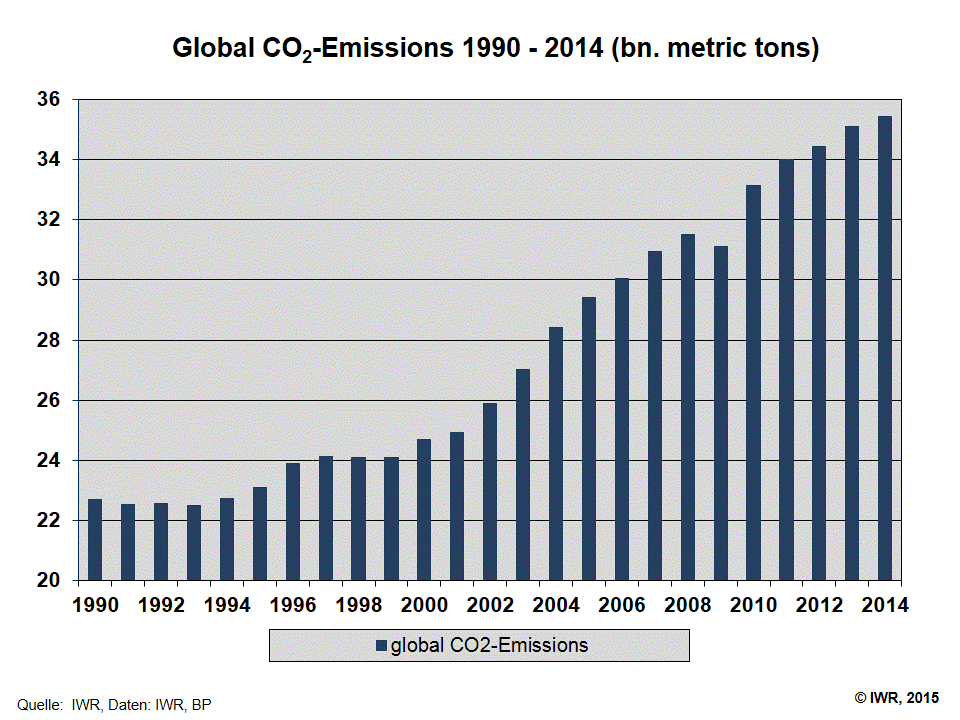The CERINA-Plan (CO2-Emissions and Renewable Investment Action Plan) was developed by the IWR, a renewable-energy institute, in 2009 following the failure of the UN Climate Conference in Copenhagen. The climate-protection model is an investment-based approach and represents an alternative to the Kyoto Protocol with its upper CO2 limits: 'investment-led thinking' instead of 'CO2 limits' – not bargaining, but investing.
CERINA plan: thinking in terms of 'investment' rather than 'CO2 limits' or 'emission budgets'
The basic idea of the CERINA plan has emerged as a consequence of the failed UN climate conference in Copenhagen in 2009 and is based on investment. Unlike limitation schemes, league tables of investments take a positive approach; this can be seen, for example, in the national league tables of gross domestic product (GDP). In the debate on investment, the focus is on innovation, growth and employment.
Investments as driver - the basic principle of the CERINA plan, how it works and how all countries can participate dependent on their own CO2 emission level
The principle of the CERINA plan: The global rise in emissions, i.e. their growth, is known exactly: it is some 500 – 700 million tonnes of CO2 a year. In retrospect, or starting from the outcome, it is possible to calculate how high annual investment must be in renewable energies as a CO2-free technology if this global growth in CO2 is to be compensated. According to calculations by the IWR Institute, it will be a world-wide investment of some EUR 500 billion a year.
Investment contributions of countries and fair distribution between the countries
The second step will be to allocate investment to different countries in accordance with a causal principle. In the IWR model, this causal allocation will reflect the CO2 emissions of a particular country, the basic principle being: the higher the CO2 emissions of a country, the greater the investment.
Taking the total level of investment and total world-wide emissions of CO2, it will be possible to calculate an investment-allocation rate per tonne of CO2 (EUR 16 per tonne of CO2). Because the CO2 emissions of every country are known, it is very simple to calculate the level of national investment in CO2-free technologies (Renewable Energy Investment target / actual comparison CERINA-Table 2014).
Countries will have strategic course of action
Benefits for the countries concerned: each country will have two options: national CO2 reduction measures, such as heat insulation, will reduce the level of investment necessary. Renewable Energy investment itself will reduce CO2 emissions. As a combined outcome, both approaches will lead to lower global CO2 emissions.
International climate protection with the CERINA Plan: benefits and effect
The CERINA Plan will overcome the current paralysis of action and, ultimately, initiate government activities and measures aimed at reducing CO2, namely through measures for CO2 reduction or avoidance (e.g. emissions trading), efficiency measures or the expansion of renewable energies.
Application example of CERINA Plan for a state and the effect of the investment model
Initial situation
Example state: Status quo - annual CO2 emissions in the amount of 100 million tonnes of CO2
CERINA Plan: 100 million tonnes of CO2 x EUR 16 per tonne = EUR 1.6 billion Target investments in renewable energy as a contribution to global climate protection
What is the political effect of the CERINA Plan?
Basically, the example state now has the choice to either reduce CO2 in various ways or invest in renewable energy. What follows are two examples of possible scenarios or courses of action for governments, selected from a wide range of possible options:
Option 1: In the example state, EUR 1.6 billion is invested in renewable energy in accordance with the CERINA Plan. As a result, the CO2 emissions reduce proportionately to global CO2 emissions. There are no further CO2 reduction measures through other instruments.
Option 2: Energy saving measures are successfully taken in the example state and emissions trading is introduced. These measures lead to a hypothetical reduction of 20 million tonnes of CO2, down to a total of only 80 million tonnes of CO2 per year. As a result, the target investment as per the CERINA Plan reduces by EUR 340 million to 80 million x EUR 16 = EUR 1.26 billion (previously: EUR 1.6 billion, see Option 1).
The 5 benefits of CERINA Plan for global climate protection
- CERINA Plan: state activities / or active investments in climate protection measures are the main focus, not the negotiating tactics
- All countries can take part in principle and are included, since energy efficient investments are possible everywhere
- The CERINA Plan explicitly takes into account the CO2 reduction measures of countries, and existing instruments such as emissions trading
- The paralysis of the states can be overcome. The investment activities in relation to the CO2 emissions of states will be presented at every UN climate conference. A public investment ranking with target/actual comparisons motivates politicians to promote investment in their own country
- A CO2 reduction is the outcome in every case, whether it is a result of investments in CO2-reduction measures or renewable energies!
Climate protection on the Kyoto model does not work: rise in CO2 since 1990 over 50 per cent
When it comes to climate protection, the international community has been arguing for many years about the right approach. Despite all efforts and UN climate conferences, the annual emission of CO2 has latterly risen to 35 billion tonnes. That is more than 50 per cent above the figure for 1990 (22.6 billion tonnes), the base value for the Kyoto Protocol. In short – the Kyoto model, involving a contractual agreement on maximum CO2 emissions, does not work.
The Kyoto cul-de-sac – why the Kyoto Protocol is not working
The core of the Kyoto Protocol is limitation or penalisation. Countries with high CO2 emissions are branded as "sinners." Climate-protection activists call repeatedly for direct limitation of CO2. The consequence: the call for reduction is answered more or less energetically, depending on the policy of each country; the best solution seems to be contractual limits on CO2. The central problem lies in the approach: every proposed limitation on CO2 in a country triggers a reflex action from the economy of that country, involving loss or relocation of jobs. And mutual confidence in any willingness to abide by treaties is bound to be low; fear that others will snatch an advantage is high. In the last resort the questions remains: who will monitor the rules at an international level, and what will the consequences be of any breach? The result: haggling every year about the level of CO2 emissions like hucksters at a fair; mutual accusations and mistrust have led finally to the cul-de-sac which is climate policy.
Thinking in terms of emissions budgets: shifting the problem onto the next generation
A modification of the Kyoto limitation approach, involving negotiation of maximum CO2 limits, has recently developed in the shape of discussion on emission budgets. The principle: if you want to reduce global warming to 1.5 or 2 degrees, only a limited amount of greenhouse gases can be emitted. In its core, this model is merely a modification of the Kyoto limitation approach. The difference: countries can be more flexible in their timeline, can overdraw their budget or carry it forward now, leaving the consequences to the next generation to sort out.
Climate protection: what will the 2015 UN Climate Conference in Paris bring?
The next UN climate conference, at which it is planned to sign a treaty, will be held in December 2015. In contrast to earlier UN climate conferences, the debate among the international community will no longer focus on inflexible country-based maximum CO2 limits. The plan, for the first time, is for countries to contribute and present their active contributions to climate protection. This change of focus could help to give rather more impetus to the climate-protection process, so long mired in stasis.
A strong signal about climate change: capital investment by countries in CO2-free technologies to trigger investment spiral
"Active contributions to climate protection, brought to bear by the various countries in Paris, will be a major initial step towards a paradigm change", says IWR director Dr. Norbert Allnoch. The first step must be followed by a second one, however. "A strong active signal to investors and business would be for each country to contribute capital investment in CO2-free technologies for climate protection at a UN climate conference. A list of countries, showing the level of planned investment, will trigger an investment spiral, which would end all haggling about maximum CO2 limits, while aiding global climate protection."
When will the global CO2 peak come?
A basic paradigm change of this kind is nowhere to be seen at this time. The new treaty is not due to come into force until 2020, and in any case China expects its CO2 peak only in 2030. "Annual CO2 emissions seem to be unstoppable; the year in which global CO2 will peak, and in which the turning point will come, cannot yet be discerned. An initial major step towards paradigm change will be made in Paris, in the shape of climate contributions by individual countries, to escape from the cul-de-sac of CO2 limitations. The next step could then be a discussion, of a kind really needed, about the capital investment to be contributed by individual countries towards global climate protection."
Links and media voices
1. CERINA-Plan (Website) showing CO2 emissions and investments in renewable energies by country 2014
2. Allnoch, N. (2009): The CERINA-Plan – An alternative to the Kyoto instrument, In: FVEE conference transcript of the annual conference on 24. November 2009 in Berlin (Englisch, German)
3. Conversation invitation by Felipe Calderon former President of Mexico, presentation of the CERINA-Plan in the forefront of Cancun 2010
4. United Nations Conference on Trade and Development: Recent developments and new challenges in commodity markets, and policy options for commodity-based inclusive growth and sustainable development (page 13 English)
5. Reuters: China, U.S. green spending falling far short, says Germany's IWR
6. BBC: Bajaron las emisiones de CO2
7. Reuters: World 2011 CO2 emissions up 2.5 percent: German institute
8. Reuters Japan: 再送:〔情報BOX〕温暖化ガス主要排出国が示した削減目標や要求
9. China, U.S. green spending falling far short, says Germany's IWR
10. Financial Bangladesh: BD needs $1.27b investment to face climate change impacts
11. The Sydney Morning Herald: C02 emissions hit new record on China surge
More media voices including quotes by IWR about the CERINA-Plan and global CO2 emissions
Years: 2009, 2010 , 2012, 2013
Latest Press releases and IWR Online informations about the CERINA-Plan and CO2 emissions
1. Record: In 2013 global CO2 emissions exceed 35 billion tonnes for the first time
2. German climate protection targets for 2020 cannot be reached (German)
3. Climate: Worldwide CO2 emissions climb 1.3% to new record level in 2012




